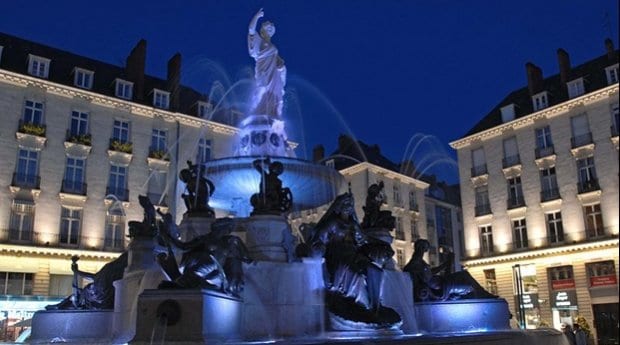The legendary Loire meanders through the imagination, confettied with castles, cathedrals and long lazy miles of medieval villages and vineyards, rolling hills and exquisite gardens. That’s all there in real life, too, along with a scatter of dynamic cities and a plentiful supply of LGBT hangouts and gay-run hotels dotted about the region, with a particular concentration in the port city of Nantes, UNESCO-venerated Orléans, cosmopolitan Tours, regal Blois and stately Amboise.
France’s longest river rises in the eastern Massif Central mountains in south-central France and runs 1,000 kilometres, north to Orléans, west through Tours, Angers and Nantes, finally reaching the Atlantic Ocean at St-Nazaire on France’s rugged west coast. The 800-kilometre Loire bike route traces the river from central Nevers (easily reached by train from Paris’s Gare de Bercy train station) to the Loire estuary. You can catch a train to various towns along the route, or there are international airports at Nantes and Tours.
Whether you want to drive it, bike it, drink it or simply drink it in, the Loire offers some stunning vineyard stops and more castles per kilometre than pretty much anywhere else on the planet. The areas surrounding Orléans and Angers are château-central, with hundreds to choose from. Many of the castles and their ornate gardens date back to the 14th century, and more than 100 châteaux are open to the public. Architectural highlights that you mustn’t miss include the fairy-tale turrets of gargantuan Chambord, the imposing Château d’Amboise in Ambois — very much the Downton Abbey of the Loire — and Chenonceau, the domain of a duo of powerful women, Diane de Poitiers and the mighty Catherine de’ Medici. For sheer fairy-tale fancy, the 16th-century Château d’Azay-le-Rideau in Touraine is the picture-perfect storybook castle.
If it’s gardens you go for, Villandry and Chaumont-sur-Loire are among the most elaborate. Summer sees many of these landscaped lawns illuminated by evening light shows. Fans of the vine should set a course for Chinon, Saumur and Sancerre. Famed for their cabernet franc and sauvignon blanc wines, the three ancient towns are all great launch points for a vineyard vacation. Don’t miss the narrow winding streets of the gorgeous medieval town La Charité if visiting nearby Sancerre.
The towns and cities of the main stretch of the river are a vibrant bunch. Jules Verne’s birthplace, Nantes, pays homage to its most famous son in the reborn river-island docklands district, now home to an enormous mechanical elephant and a carousel of giant sea creatures. This redeveloped, five-kilometre-long island kickstarted Nantes’s transformation from staid provincial spot to hip weekend destination. Now sidewalk cafés hem cobbled streets, and hip bars and bistros dot the docks. It’s a city with something of a split personality: Nantes was the capital of Brittany until the Second World War, and this once proudly Breton burgh has a unique air. It’s the sixth-largest city in France and is home to more than 800,000 people. It’s famed for its crêpes; its museum of fine arts; its elegant covered shopping area, the Passage Pommeraye; and a slew of quirky art installations. There are also a couple of castles, of course: the fine Château des Ducs de Bretagne and the orderly Château de Goulaine.
Orléans, birthplace of France’s first and foremost feminist, Joan of Arc, offers the neo-Gothic Ste-Croix cathedral and a great base for chateau visits. Tours, a city with a metropolitan population of more than half a million, dates back to the fourth century but is particularly known for its 12-century cathedral. Angers is famed for its medieval château, founded in the ninth century and expanded in the 13th. It’s in this palatial pad that you’ll find the 700-year-old Apocalypse Tapestry, which was presumably a more popular decorative theme in the 1300s than it is today.
Bars
Nantes and the departmental capitals Orléans and Tours are the best bets for bar life. In Nantes, you’ll find rainbow-decked options on Rue Kervégan, including the lively Le Petit Marais. Orléans’s hottest homo haunt is Le Sweet & Co cocktail bar. Tours’s top LGBT addresses include Vieux Murier. But even in unexpected, seemingly off-radar spots, you’ll find family. Try L’Escale, a diminutive bar-restaurant with a charming patio garden in tiny St-Bouize, in the Centre départment near Nevers. A bar, restaurant, épicérie and dépôt de pain, it’s the centre of village life and is run by a charming gay couple named Stefan and Gael.
Accommodations
You’ll find a perfectly manicured handful of queer-friendly properties around Amboise. Try Amboise’s gay-owned, 18th-century Manoir les Minimes. Orléans’s LGBT-welcoming Hôtel de L’Abeille is in the town centre and is run by a friendly brother-and-sister team. In keeping with its newfound hipness, Nantes has a clutch of good design hotels, such as the 28-room Sozo, a super stylish spot situated in a former 19th-century chapel.

 Why you can trust Xtra
Why you can trust Xtra